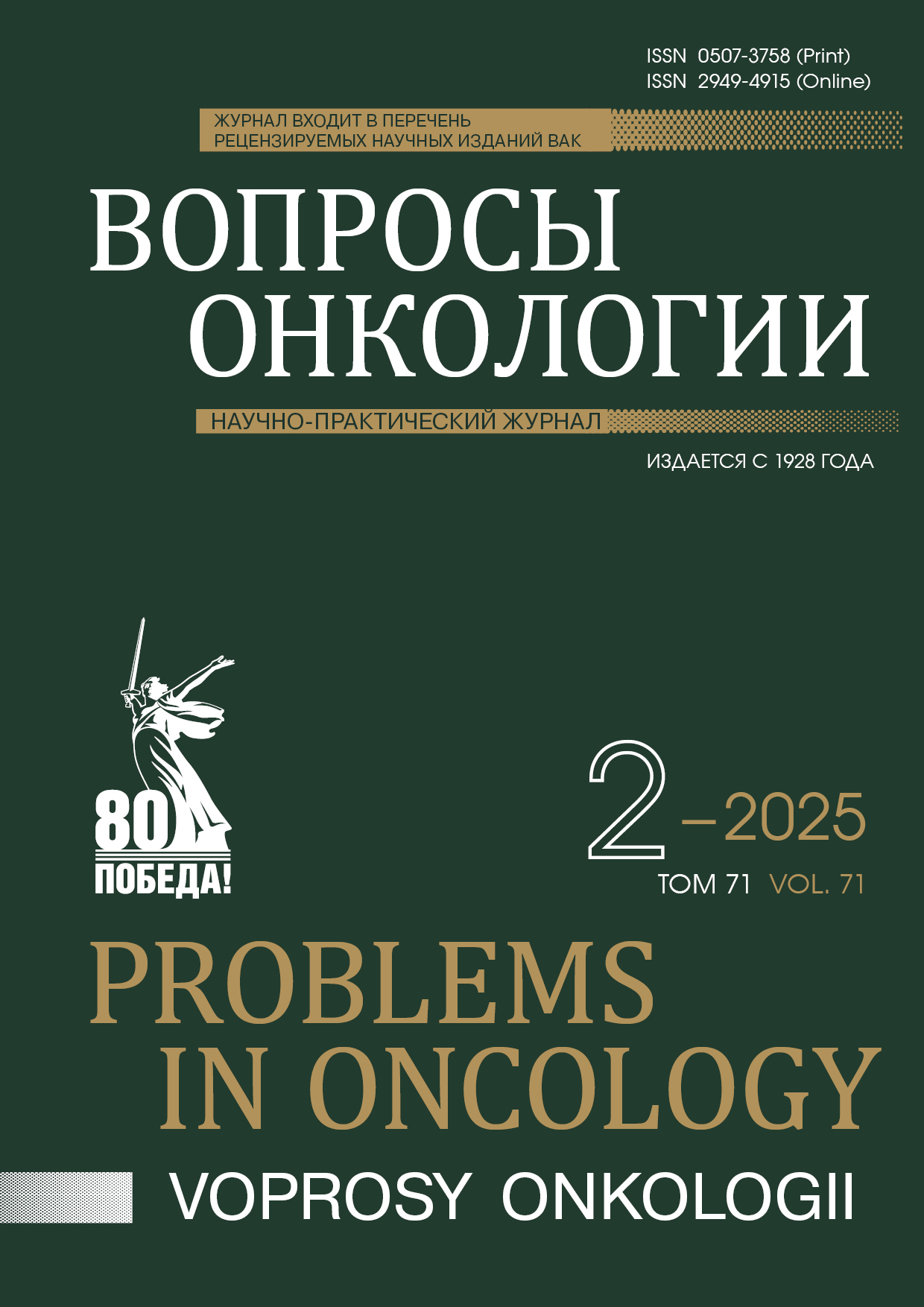摘要
Введение. Микросателлитная нестабильность (MSI) является следствием дефекта системы репарации неспаренных оснований ДНК и сопровождается накоплением множества мутаций в ткани опухоли. Этот феномен характерен для колоректальных опухолей, карцином желудка, рака эндометрия и некоторых других типов новообразований. MSI в опухолях часто сочетается с активацией сигнального пути MAPK, в частности с мутациями в генах KRAS, NRAS и BRAF. Недавние исследования показали, что в опухолях с микросателлитной нестабильностью также могут встречаться транслокации с участием тирозинкиназ ALK, ROS1, RET и NTRK1-3.
Цель. Изучить частоту и спектр активирующих транслокаций тирозинкиназ при опухолях разных локализаций с микросателлитной нестабильностью.
Материалы и методы. Статус MSI был определен для 27 408 новообразований. Выявление перестроек с участием генов ALK, ROS1, RET и NTRK1-3 в 1284 образцах MSI-позитивных опухолей осуществлялось при помощи тестов по определению несбалансированной экспрессии 5’/3’-концов гена, вариант-специфической ПЦР и высокопроизводительного секвенирования РНК (РНК-NGS).
Результаты. Перестройки были обнаружены в 101/990 (10,2 %) случае колоректального рака и 1/108 (1 %) опухоли желудка (ALK: 11; RET: 25; NTRK1: 42; NTRK2: 2; NTRK3: 22), и не были выявлены при раке эндометрия (n = 157), шейки матки (n = 13), поджелудочной железы (n = 7), холангиокарциноме (n = 4) или раке яичника (n = 5). Самой высокой частота транслокаций оказалась среди KRAS/NRAS/BRAF-негативных колоректальных карцином с MSI 93/395 (23,5 %). Гораздо реже перестройки обнаруживались при раке толстой кишки с мутациями KRAS/NRAS/BRAF (8/597, 1,3 %). При раке толстой кишки присутствие транслокаций ассоциировалось с возрастом старше 50 лет ((97/795 (12,2 %) vs 3/195 (1,5 %), p = 0,0002)).
Выводы. Транслокации с участием генов тирозинкиназ встречаются со значительной частотой при MSI-позитивном раке толстой кишки, в особенности при KRAS/NRAS/BRAF-негативных опухолях.
参考
Shia J. The diversity of tumours with microsatellite instability: molecular mechanisms and impact upon microsatellite instability testing and mismatch repair protein immunohistochemistry. Histopathology. 2021; 78(4): 485-497.-DOI: https://doi.org/10.1111/his.14271.
Wang J., Li R., Li J., et al. Comprehensive analysis of oncogenic fusions in mismatch repair deficient colorectal carcinomas by sequential DNA and RNA next generation sequencing. J Transl Med. 2021; 19(1): 433.-DOI: https://doi.org/10.1186/s12967-021-03108-6.
Gallon R., Gawthorpe P., Phelps R.L., et al. How should we test for lynch syndrome? A review of current guidelines and future strategies. Cancers (Basel). 2021; 13(3): 406.-DOI: https://doi.org/10.3390/cancers13030406.
Taieb J., Svrcek M., Cohen R., et al. Deficient mismatch repair/microsatellite unstable colorectal cancer: Diagnosis, prognosis and treatment. Eur J Cancer. 2022; 175: 136-157:-DOI: https://doi.org/10.1016/j.ejca.2022.07.020.
Eso Y., Shimizu T., Takeda H., et al. Microsatellite instability and immune checkpoint inhibitors: toward precision medicine against gastrointestinal and hepatobiliary cancers. J Gastroenterol. 2020; 55(1): 15-26.-DOI: https://doi.org/10.1007/s00535-019-01620-7.
Jin Z., Sinicrope F.A. Mismatch repair-deficient colorectal cancer: building on checkpoint blockade. J Clin Oncol. 2022; 40(24): 2735-2750.-DOI: https://doi.org/10.1200/JCO.21.02691.
Imyanitov E., Kuligina E. Molecular testing for colorectal cancer: Clinical applications. World J Gastrointest Oncol. 2021; 13(10): 1288-1301.-DOI: https://doi.org/10.4251/wjgo.v13.i10.1288.
Vaňková B., Vaněček T., Ptáková N., et al. Targeted next generation sequencing of MLH1-deficient, MLH1 promoter hypermethylated, and BRAF/RAS-wild-type colorectal adenocarcinomas is effective in detecting tumors with actionable oncogenic gene fusions. Genes Chromosomes & Cancer. 2020; 59(10): 562-568.-DOI: https://doi.org/10.1002/gcc.22861.
Bocciarelli C., Caumont C., Samaison L., et al. MSI-High RAS-BRAF wild-type colorectal adenocarcinomas with MLH1 loss have a high frequency of targetable oncogenic gene fusions whose diagnoses are feasible using methods easy-to-implement in pathology laboratories. Hum Pathol. 2021; 114: 99-109.-DOI: https://doi.org/10.1016/j.humpath.2021.05.006.
Singh H., Li Y.Y., Spurr L.F., et al. Molecular characterization and therapeutic targeting of colorectal cancers harboring receptor tyrosine kinase fusions. Clin Cancer Res. 2021; 27(6): 1695-1705.-DOI: https://doi.org/10.1158/1078-0432.CCR-20-4073.
Madison R.W., Hu X., Ramanan V., et al. Clustered 8-oxo-guanine mutations and oncogenic gene fusions in microsatellite-unstable colorectal cancer. JCO Precis Oncol. 2022: 6: e2100477.-DOI: https://doi.org/10.1200/PO.21.00477.
Okano S., Yamashiro Y., Onagi H., et al. Tyrosine kinase alterations in colorectal cancer with emphasis on the distinct clinicopathological characteristics. Histopathology. 2023; 83(5): 733-742.-DOI: https://doi.org/10.1111/his.15015.
Kurnit K.C., Westin S.N., Coleman R.L. Microsatellite instability in endometrial cancer: New purpose for an old test. Cancer. 2019; 125(13): 2154-2163.-DOI: https://doi.org/10.1002/cncr.32058.
Puliga E., Corso S., Pietrantonio F., et al. Microsatellite instability in gastric cancer: between lights and shadows. Cancer Treat Rev. 2021; 95: 102175.-DOI: https://doi.org/10.1016/j.ctrv.2021.102175.
Preobrazhenskaya E.V., Suleymanova A.M., Bizin I.V., et al. Spectrum of kinase gene rearrangements in a large series of paediatric inflammatory myofibroblastic tumours. Histopathology. 2023; 83(1): 109-115.-DOI: https://doi.org/10.1111/his.14912.
Tiurin V.I., Preobrazhenskaya E.V., Mitiushkina N.V., et al. Rapid and cost-efficient detection of RET rearrangements in a large consecutive series of lung carcinomas. Int J Mol Sci. 2023; 24(13): 10530.-DOI: https://doi.org/10.3390/ijms241310530.
Martianov A.S., Mitiushkina N.V., Ershova A.N., et al. KRAS, NRAS, BRAF, HER2 and MSI status in a large consecutive series of colorectal carcinomas. Int J Mol Sci. 2023; 24(5): 4868.-DOI: https://doi.org/10.3390/ijms24054868.
Zhou X.P., Hoang J.M., Li Y.J., et al. Determination of the replication error phenotype in human tumors without the requirement for matching normal DNA by analysis of mononucleotide repeat microsatellites. Genes Chromosomes & Cancer. 1998; 21: 101-107.-DOI: https://doi.org/10.1002/(sici)1098-2264(199802)21:2<101::aid-gcc4>3.0.co;2-4.
Suraweera N., Duval A., Reperant M., et al. Evaluation of tumor microsatellite instability using five quasimonomorphic mononucleotide repeats and pentaplex PCR. Gastroenterology. 2002; 123: 1804-1811.-DOI: https://doi.org/10.1053/gast.2002.37070.
Afrăsânie V.A., Gafton B., Marinca M.V., et al. The coexistence of RAS and BRAF mutations in metastatic colorectal cancer: a case report and systematic literature review. J Gastrointestin Liver Dis. 2020; 29(2): 251-256.-DOI: https://doi.org/10.15403/jgld-1003.
Uchida S., Kojima T., Sugino T. Frequency and clinicopathological characteristics of patients with KRAS/BRAF double-mutant colorectal cancer: an in silico study. Pathol Oncol Res. 2022; 28: 1610206.-DOI: https://doi.org/10.3389/pore.2022.1610206.
Mustachio L.M., Roszik J. Single-cell sequencing: current applications in precision onco-genomics and cancer therapeutics. Cancers (Basel). 2022; 14(3): 657.-DOI: https://doi.org/10.3390/cancers14030657.
O'Haire S., Franchini F., Kang, Y.J., et al. Systematic review of NTRK 1/2/3 fusion prevalence pan-cancer and across solid tumours. Sci Rep. 2023; 13: 4116.-DOI: https://doi.org/10.1038/s41598-023-31055-3.
Romanko A.A., Mulkidjan R.S., Tiurin V.I., et al. Cost-efficient detection of NTRK1/2/3 gene fusions: single-center analysis of 8075 tumor samples. Int J Mol Sci. 2023; 24(18): 14203.-DOI: https://doi.org/10.3390/ijms241814203.
Fois S.S., Paliogiannis P., Zinellu A., et al. Molecular epidemiology of the main druggable genetic alterations in non-small cell lung cancer. Int J Mol Sci. 2021; 22(2): 612.-DOI: https://doi.org/10.3390/ijms22020612.

This work is licensed under a Creative Commons Attribution-NonCommercial-NoDerivatives 4.0 International License.
© АННМО «Вопросы онкологии», Copyright (c) 2025

